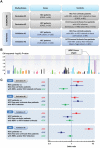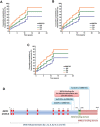BRIP1 coding variants are associated with a high risk of hepatocellular carcinoma occurrence in patients with HCV- or HBV-related liver disease
- PMID: 28968953
- PMCID: PMC5609885
- DOI: 10.18632/oncotarget.11327
BRIP1 coding variants are associated with a high risk of hepatocellular carcinoma occurrence in patients with HCV- or HBV-related liver disease
Abstract
The molecular mechanisms of hepatocellular carcinoma (HCC) carcinogenesis are still not fully understood. DNA repair defects may influence HCC risk. The aim of the study was to look for potential genetic variants of DNA repair genes associated with HCC risk among patients with alcohol- or viral-induced liver disease. We performed four case-control studies on 2,006 European- (Derivation#1 and #2 studies) and African-ancestry (Validation#1 and #2 studies) patients originating from several cohorts in order to assess the association between genetic variants on DNA repair genes and HCC risk using a custom array encompassing 94 genes. In the Derivation#1 study, the BRIP1 locus reached array-wide significance (Chi-squared SV-Perm, P=5.00×10-4) among the 253 haplotype blocks tested for their association with HCC risk, in patients with viral cirrhosis but not among those with alcoholic cirrhosis. The BRIP1 haplotype block included three exonic variants (rs4986763, rs4986764, rs4986765). The BRIP1 'AAA' haplotype was significantly associated with an increased HCC risk [odds ratio (OR), 2.01 (1.19-3.39); false discovery rate (FDR)-P=1.31×10-2]. In the Derivation#2 study, results were confirmed for the BRIP1 'GGG' haplotype [OR, 0.53 (0.36-0.79); FDR-P=3.90×10-3]. In both Validation#1 and #2 studies, BRIP1 'AAA' haplotype was significantly associated with an increased risk of HCC [OR, 1.71 (1.09-2.68); FDR-P=7.30×10-2; and OR, 6.45 (4.17-9.99); FDR-P=2.33×10-19, respectively]. Association between the BRIP1 locus and HCC risk suggests that impaired DNA mismatch repair might play a role in liver carcinogenesis, among patients with HCV- or HBV-related liver disease.
Keywords: BRIP1; DNA repair genes; hepatitis B virus; hepatitis C virus; hepatocellular carcinoma.
Conflict of interest statement
CONFLICTS OF INTEREST The authors who have taken part in this study declared that they do not have anything to disclose regarding funding or conflict of interest with respect to this manuscript.
Figures


References
-
- El-Serag HB. Hepatocellular carcinoma. N Engl J Med. 2011;365:1118–1127. - PubMed
LinkOut - more resources
Full Text Sources
Other Literature Sources
Research Materials
Miscellaneous

